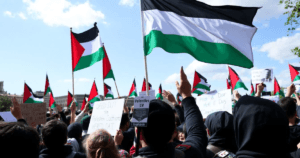75 Protesters Rally Against Penn Hillel Event – Shocking Demonstration Sparks Controversy
Around 75 pro-Palestinian protesters gathered near Penn Hillel on March 31 to oppose an event featuring Israeli activist Noa Tishby and two survivors of the October 7 Hamas attacks. The demonstration, part of the “All Out for Palestine Rally,” began at 30th and Market streets before moving down Walnut Street and stopping near Penn Hillel. Organizers distributed mock newspapers titled “The New York War Crimes” and flyers advocating against U.S. aid to Israel. A speaker highlighted that the protest coincided with “Land Day,” a Palestinian commemoration of Israel’s 1976 land confiscation.
Protesters chanted against Penn and Hillel, with some making hand gestures resembling symbols linked to Hamas, while members of the Sigma Alpha Mu fraternity displayed an Israeli flag in response. Authorities, including Penn and Philadelphia Police, maintained a strong presence and temporarily closed sections of Walnut Street. The protest also addressed the recent deportation of pro-Palestinian student activists, with a speaker vowing to stand against ICE actions on campus. Requests for comments from Penn Hillel, the university, and Tishby remained unanswered.

75 Protesters Rally Against Penn Hillel Event – Shocking Demonstration Sparks Controversy
On March 31, approximately 75 pro-Palestinian demonstrators gathered near Penn Hillel, a Jewish cultural center at the University of Pennsylvania, to protest an event featuring Israeli activist Noa Tishby and two survivors of the October 7, 2023, Hamas attacks. Organized as part of an “All Out for Palestine Rally,” the demonstration began at 4:30 p.m. at the intersection of 30th and Market Streets in Philadelphia before moving along Walnut Street and stopping near Penn Hillel.
The protest, marked by chants and symbolic gestures, centered on opposition to U.S. support for Israel and solidarity with Palestinian causes. Participants distributed mock newspapers titled The New York War Crimes, which described Palestine as “the land of the people,” alongside flyers from the group Workers’ Voice demanding an end to American financial and military aid to Israel. Organizers emphasized that the rally coincided with “Land Day,” an annual commemoration of the 1976 Israeli confiscation of Palestinian land, which remains a touchstone for activism.
Criticism of Israeli Speaker and Penn Hillel
Protesters directed their criticism at Noa Tishby, a vocal advocate for Israel, and Penn Hillel, accusing both of promoting narratives they view as harmful to Palestinian rights. Chants targeting the university and Hillel echoed through the crowd, with some participants making hand gestures resembling symbols linked to Hamas, the militant group governing Gaza. While the gestures were not explicitly explained during the protest, their use drew attention given Hamas’s designation as a terrorist organization by the U.S. and other governments.
Across the street, members of Penn’s Sigma Alpha Mu fraternity countered the demonstration by displaying a large Israeli flag from their house as the crowd passed. The visual contrast underscored the deepening tensions on campus over the Israeli-Palestinian conflict, which have intensified since the October 7 attacks and Israel’s subsequent military campaign in Gaza.
Heavy Police Presence and Campus Safety Measures
Authorities, including Penn Police, Philadelphia Police, and Drexel University Police, monitored the event closely, temporarily closing sections of Walnut Street to manage the crowd. The university’s Division of Public Safety issued an advisory ahead of the rally, warning students and residents about potential traffic disruptions. Despite heightened emotions, no physical confrontations or arrests were reported.
Broader Activism and Student Deportation Concerns
Beyond Middle East policy, the rally also addressed recent incidents involving pro-Palestinian student activists. A speaker highlighted the deportation of several international students engaged in pro-Palestinian advocacy, vowing to resist what they described as overreach by U.S. Immigration and Customs Enforcement (ICE). “We will not let ICE intimidate or silence our voices on campus,” the speaker declared, linking the issue to broader calls for academic freedom and immigrant rights.
Context and Silence from Key Parties
The protest occurred amid ongoing debates at Penn over free speech, campus safety, and the boundaries of political activism. In recent months, pro-Palestinian and pro-Israeli groups have held competing events, with some escalating into accusations of harassment or antisemitism. The university has faced pressure to balance student safety with constitutional protections for protest.
Requests for comment from Penn Hillel, the University of Pennsylvania, and Noa Tishby went unanswered at the time of reporting. Penn Hillel, which hosts cultural and educational programs related to Jewish life, has previously emphasized its commitment to fostering dialogue while ensuring a safe environment for students.
Symbolism and Competing Narratives
The mock newspaper distributed at the rally, The New York War Crimes, framed Israel’s actions in Gaza as violations of international law, reflecting organizers’ focus on human rights critiques. Meanwhile, Workers’ Voice flyers tied U.S. foreign aid to Israel to domestic issues, arguing that taxpayer funds should address “housing, healthcare, and education here at home instead of funding occupation abroad.”
For many protesters, Land Day served as a reminder of historical grievances, particularly Israel’s 1976 expropriation of Arab-owned land in the Galilee region — a move that sparked protests and fatalities. The annual commemoration has since become a rallying point for Palestinian solidarity movements worldwide.
Conclusion
The demonstration near Penn Hillel highlighted the ongoing polarization surrounding the Israeli-Palestinian conflict on college campuses. While protesters called for accountability and solidarity, counteractions like the fraternity’s Israeli flag display illustrated the deeply personal stakes for many students. As universities navigate these divisions, the balance between free expression, safety, and inclusivity remains a pressing challenge.
The absence of responses from Penn Hillel, the university, and Noa Tishby leaves unresolved questions about how institutions and public figures address such protests. For now, the event underscores the enduring impact of global conflicts on local communities — and the power of activism to keep these issues in the spotlight.
You must be logged in to post a comment.